Published: 12 March 2021
Completion of university of applied sciences education faster than before, large differences between sexes
According to Statistics Finland’s education statistics, completion of university of applied sciences education and university education accelerated. In turn, the completion of vocational education and upper secondary general school education slowed down. In all, 57 per cent of those having started studies completed a university of applied sciences degree in four-and-a-half years in 2019, while in the previous statistical year 53 per cent completed a university of applied sciences degree within the target period.
Pass rates by sector of education, %
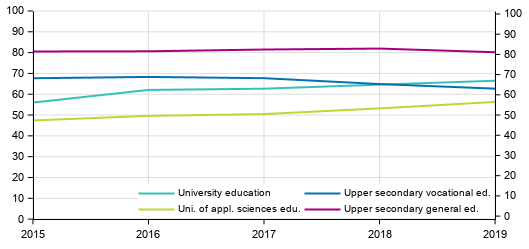
The pass rate tells how many per cent of those that started education have completed a qualification within the examined study time. The examined time is 3.5 years for upper secondary general and vocational education. 4.5 years for university of applied sciences education and 5.5 years for university education.
In upper secondary general school education, 80 per cent passed the matriculation examination in at most three-and-a-half years. The pass rate of upper secondary general school education is stable and a high percentage of those having started the education pass the examination. In 2015, altogether 81 per cent of those having started upper secondary general school education passed it, in which case the share of those having passed the education within the target period has fallen by one percentage point in five years. Of those having started initial vocational qualifications, 63 per cent completed a qualification within the target period, while 68 per cent completed a qualification within the target period in 2015. During the reference period, the pass rate of initial vocational education was at its highest in 2016, when 68 per cent of the students having started the education completed it within the target period. The pass rate of initial vocational education has fallen for the past four statistical years in a row.
In 2019, more students completed both university of applied sciences education and university education than before. In all, 57 per cent of those having started university of applied sciences education completed it within the target period, while in 2015 the share of those having completed it within the target period was 47 per cent. The share of those having completed education within the target period has grown by ten percentage points in five years. Sixty-six per cent of university students completed a higher or lower university degree in at most five-and-a-half years. The pass rate of university education has grown by 10 percentage points in five years.
Pass rates for upper secondary general education by gender in different reference periods in 2019
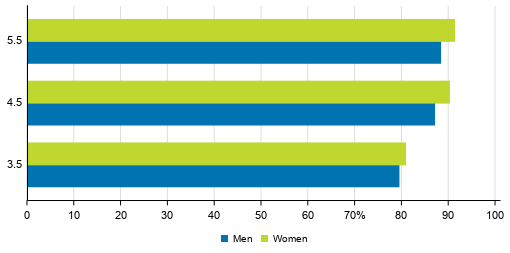
According to the data for 2019, upper secondary general school education was completed typically in 3.5 to 4.5 years: Eighty per cent of new students in upper secondary general schools completed the upper secondary general school syllabus in at most three-and-a-half years and 89 per cent in at most four-and-a-half years. Men studying in upper secondary general school passed their qualifications slightly slower than women studying there did. Altogether 81 per cent of women and 79 per cent of men completed upper secondary general school education in three-and-a-half years, whereby the difference between the sexes was two percentage points. Ninety per cent of women and 87 per cent of men completed upper secondary general school education in four-and-a-half years, which meant that the difference between the sexes was three percentage points.
Pass rates for initial vocational education by gender in different reference periods in 2019
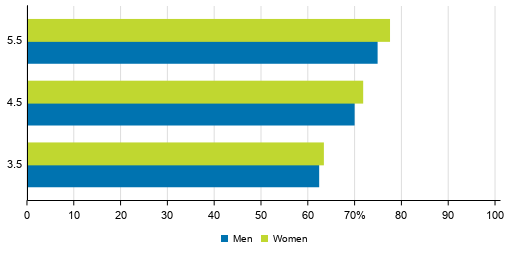
The duration of completing initial vocational education varies more than that of upper secondary general qualifications. Sixty-five per cent of vocational education students passed their vocational qualifications in three and a half years or faster. Seventy-three per cent of students completed their education in at most four and a half years
The completion time for vocational education varied between men and women. Sixty-two per cent of male students passed a vocational qualification in three-and-a-half years and 70 per cent in four-and-a-half years. Sixty-three per cent of female students passed a vocational qualification in three-and-a-half years and 72 per cent in four-and-a-half years.
Pass rates for university of applied sciences education by gender in different reference periods in 2019
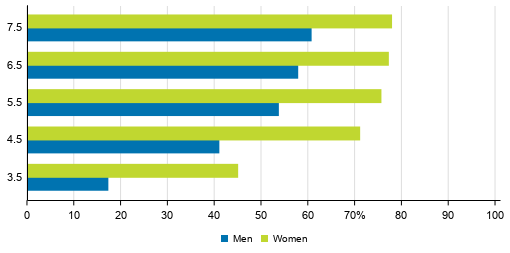
Fifty-seven per cent of those who started studying for a university of applied sciences degree completed their studies in four-and-a-half years. Sixty-five per cent of those having started studies completed a qualification in five-and-a-half years. Six-and-a-half years after starting studies the pass rate rose to 68 per cent.
There are large differences in attainment of university of applied sciences education between the genders. Forty-one per cent of men completed a qualification in four-and-a-half years and 71 per cent of women, so the difference between the pass rates was 30 percentage points. Men's pass rate rose to 54 per cent and women's to 76 per cent five-and-a-half years after starting studies. The difference in the pass rates was then 22 percentage points. Sixty-one per cent of men and 78 per cent of women completed education in seven-and-a-half years, that is, the difference between the pass rates was 17 percentage points.
Pass rates for university education by gender in different reference periods in 2018
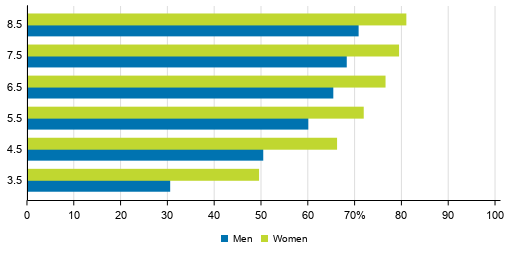
Sixty-seven per cent of university students completed a higher or lower university degree in at most five-and-a-half years. The older the cohort of new students is examined, the higher the pass rate became: 74 per cent of students completed a higher or lower university degree in at most seven-and-a-half years.
As in university of applied sciences education, there were large differences between sexes in completing university education. Sixty per cent of male students and 72 per cent of female students had completed a higher or lower university degree in five-and-a-half years, so the difference between sexes in pass rates was 12 per cent. In at most seven-and-a-half years, 79 per cent of women and 68 per cent of men completed university education.
The database tables of these statistics contain information on the differences between the pass rates for different fields of sectors of education (see Tables in databases ). The database tables also include information on those students who did not attain their qualification in the target time.
More statistics on student flow statistics. ( Discontinuation of education , Employment of students ).
Source: Education Statistics, Statistics Finland
Inquiries: Mika Witting 029 551 3530, koulutustilastot@stat.fi
Head of Department in charge: Hannele Orjala
Publication in pdf-format (285.8 kB)
- Tables
-
Tables in databases
Pick the data you need into tables, view the data as graphs, or download the data for your use.
Appendix tables
- Appendix table 1. Progress of new upper secondary school students (aimed at young people) studies by end 2019 (12.3.2021)
- Appendix table 2. Progress of new students studies in vocational education (aimed at young people) by end 2019 (12.3.2021)
- Appendix table 3. Progress of new university of applied sciences students studies by end 2019, youth education (12.3.2021)
- Appendix table 4. Progress of new university students studies by end 2019, lower or higher university degrees (12.3.2021)
Updated 12.3.2021
Official Statistics of Finland (OSF):
Progress of studies [e-publication].
ISSN=1799-1021. 2020. Helsinki: Statistics Finland [referred: 10.3.2025].
Access method: http://stat.fi/til/opku/2020/opku_2020_2021-03-12_tie_001_en.html

